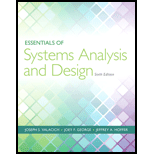
Essentials of Systems Analysis and Design (6th Edition)
6th Edition
ISBN: 9780133546231
Author: Joseph Valacich, Joey George
Publisher: PEARSON
expand_more
expand_more
format_list_bulleted
Question
Chapter 3, Problem 1RQ
Program Plan Intro
- Information system refers to the group of people, data, procedures, hardware, and software in an organization which process the information and data.
- It monitors the transactions details, provides the required information to decision makers, and provides necessary documents to the customers.
- The main components in information system include people, data, procedures, hardware, and software.
- The main function of information system is to accept and process the input data, store the retrieved information and distribute it across the organization.
Expert Solution & Answer
Want to see the full answer?
Check out a sample textbook solution
Students have asked these similar questions
I need to define and discuss the uses of one monitoring or troubleshooting tool in Windows Server 2019. thank you
I would likr toget help with the following concepts:
- Windows Server features
- Windows Server versus Windows 10 used as a client-server network
I need to define and discuss the uses of one monitoring or troubleshooting tool in Windows Server 2019. thank you
Chapter 3 Solutions
Essentials of Systems Analysis and Design (6th Edition)
Ch. 3 - An online or hard-copy repository for all project...Ch. 3 - Prob. 2MCh. 3 - Prob. 3MCh. 3 - Prob. 4MCh. 3 - Prob. 5MCh. 3 - Prob. 6MCh. 3 - Prob. 7MCh. 3 - Prob. 8MCh. 3 - Prob. 9MCh. 3 - The process of dividing the project into...
Ch. 3 - Prob. 11MCh. 3 - A graphical representation of a project that shows...Ch. 3 - Prob. 13MCh. 3 - Prob. 14MCh. 3 - A systems analyst with a diverse set of...Ch. 3 - The second phase of the project management...Ch. 3 - Prob. 17MCh. 3 - Prob. 18MCh. 3 - Prob. 19MCh. 3 - Prob. 20MCh. 3 - Prob. 1RQCh. 3 - Prob. 2RQCh. 3 - Prob. 3RQCh. 3 - Prob. 4RQCh. 3 - Prob. 5RQCh. 3 - Prob. 6RQCh. 3 - Prob. 7RQCh. 3 - Prob. 8RQCh. 3 - Prob. 9RQCh. 3 - Describe the steps involved in making a network...Ch. 3 - In which phase of the systems development life...Ch. 3 - What are some reasons why one activity may have to...Ch. 3 - Which of the four phases of the project management...Ch. 3 - What are some sources of risk in a systems...Ch. 3 - Search the Web for recent reviews of project...Ch. 3 - Prob. 16PECh. 3 - Prob. 17PECh. 3 - Prob. 18PECh. 3 - Prob. 19PECh. 3 - Construct a Gantt chart for the project defined in...Ch. 3 - Look again at the activities outlined in Problem...Ch. 3 - Prob. 25PECh. 3 - Prob. 26PECh. 3 - Prob. 27PECh. 3 - Prob. 29PECh. 3 - Prob. 30PECh. 3 - Prob. 31PECh. 3 - Prob. 32PECh. 3 - Prob. 33DQCh. 3 - Do you agree that breaking projects down into...Ch. 3 - Microsoft Project is powerful but expensive....Ch. 3 - When completing a project, some tasks are...Ch. 3 - a. While eating lunch one day, Juanita asked Chris...Ch. 3 - What qualities might Jim possess that would make...Ch. 3 - Prob. 41CQCh. 3 - Prob. 42CQCh. 3 - What should Jim do next to complete the project...Ch. 3 - Prob. 44CQ
Knowledge Booster
Similar questions
- Please solve and answer the questions correctly please. Thank you!!arrow_forwardConsidering the TM example of binary sum ( see attached)do the step-by-step of execution for the binary numbers 1101 and 11. Feel free to use the Formal Language Editor Tool to execute it; Write it down the current state of the tape (including the head position) and indicate the current state of the TM at each step.arrow_forwardI need help on inculding additonal code where I can can do the opposite code of MatLab, where the function of t that I enter becomes the result of F(t), in other words, turning the time-domain f(t) into the frequency-domain function F(s):arrow_forward
arrow_back_ios
SEE MORE QUESTIONS
arrow_forward_ios
Recommended textbooks for you
 Fundamentals of Information SystemsComputer ScienceISBN:9781305082168Author:Ralph Stair, George ReynoldsPublisher:Cengage Learning
Fundamentals of Information SystemsComputer ScienceISBN:9781305082168Author:Ralph Stair, George ReynoldsPublisher:Cengage Learning Fundamentals of Information SystemsComputer ScienceISBN:9781337097536Author:Ralph Stair, George ReynoldsPublisher:Cengage Learning
Fundamentals of Information SystemsComputer ScienceISBN:9781337097536Author:Ralph Stair, George ReynoldsPublisher:Cengage Learning Enhanced Discovering Computers 2017 (Shelly Cashm...Computer ScienceISBN:9781305657458Author:Misty E. Vermaat, Susan L. Sebok, Steven M. Freund, Mark Frydenberg, Jennifer T. CampbellPublisher:Cengage Learning
Enhanced Discovering Computers 2017 (Shelly Cashm...Computer ScienceISBN:9781305657458Author:Misty E. Vermaat, Susan L. Sebok, Steven M. Freund, Mark Frydenberg, Jennifer T. CampbellPublisher:Cengage Learning Principles of Information Systems (MindTap Course...Computer ScienceISBN:9781285867168Author:Ralph Stair, George ReynoldsPublisher:Cengage Learning
Principles of Information Systems (MindTap Course...Computer ScienceISBN:9781285867168Author:Ralph Stair, George ReynoldsPublisher:Cengage Learning Principles of Information Systems (MindTap Course...Computer ScienceISBN:9781305971776Author:Ralph Stair, George ReynoldsPublisher:Cengage Learning
Principles of Information Systems (MindTap Course...Computer ScienceISBN:9781305971776Author:Ralph Stair, George ReynoldsPublisher:Cengage Learning Management Of Information SecurityComputer ScienceISBN:9781337405713Author:WHITMAN, Michael.Publisher:Cengage Learning,
Management Of Information SecurityComputer ScienceISBN:9781337405713Author:WHITMAN, Michael.Publisher:Cengage Learning,

Fundamentals of Information Systems
Computer Science
ISBN:9781305082168
Author:Ralph Stair, George Reynolds
Publisher:Cengage Learning

Fundamentals of Information Systems
Computer Science
ISBN:9781337097536
Author:Ralph Stair, George Reynolds
Publisher:Cengage Learning

Enhanced Discovering Computers 2017 (Shelly Cashm...
Computer Science
ISBN:9781305657458
Author:Misty E. Vermaat, Susan L. Sebok, Steven M. Freund, Mark Frydenberg, Jennifer T. Campbell
Publisher:Cengage Learning

Principles of Information Systems (MindTap Course...
Computer Science
ISBN:9781285867168
Author:Ralph Stair, George Reynolds
Publisher:Cengage Learning

Principles of Information Systems (MindTap Course...
Computer Science
ISBN:9781305971776
Author:Ralph Stair, George Reynolds
Publisher:Cengage Learning

Management Of Information Security
Computer Science
ISBN:9781337405713
Author:WHITMAN, Michael.
Publisher:Cengage Learning,